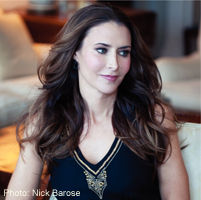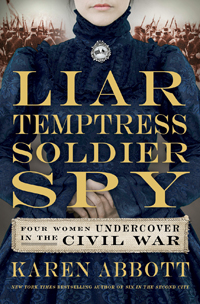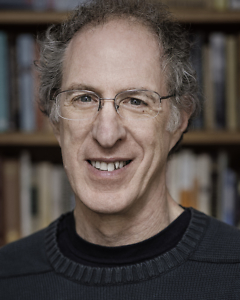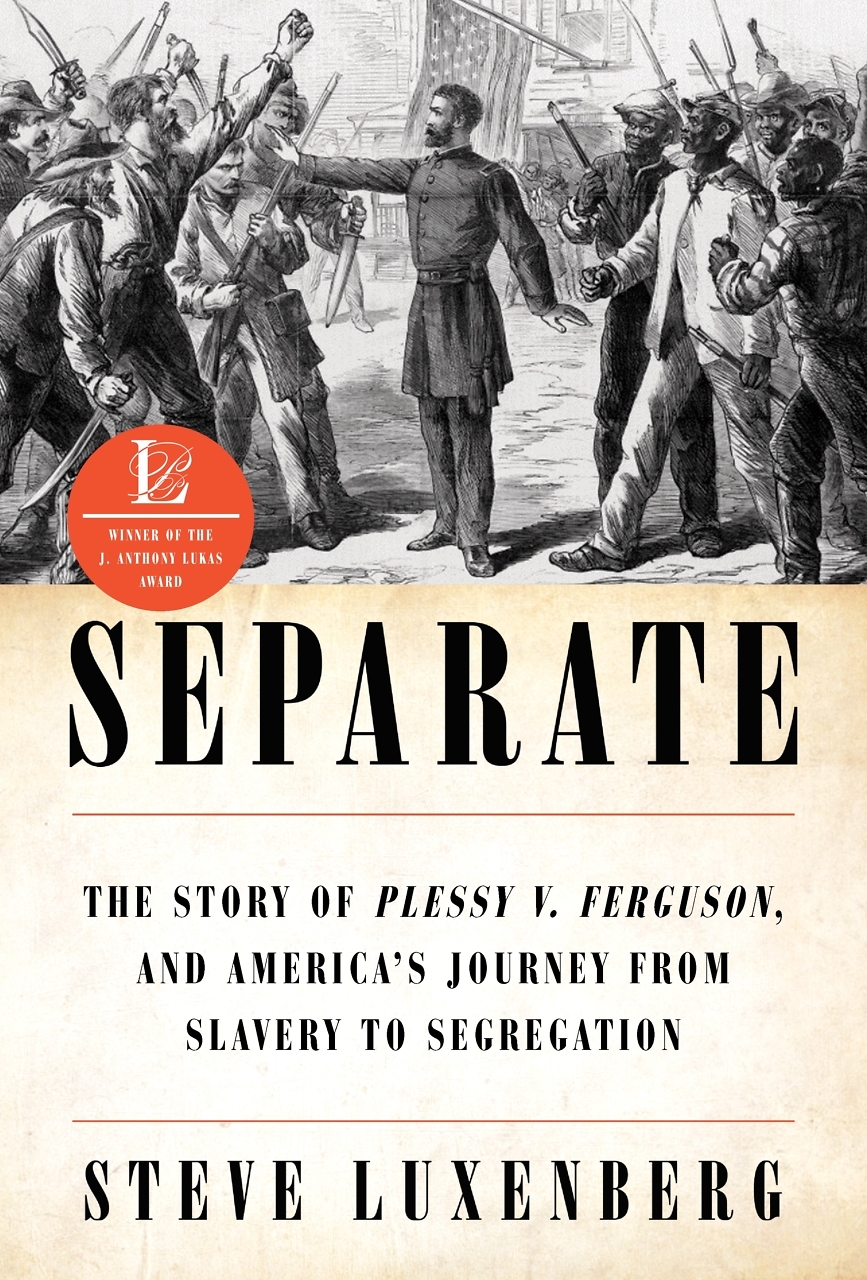The John le Carré of Civil-War Espionage
Karen Abbott talks with Chapter 16 about her new work of nonfiction, Liar, Temptress, Soldier, Spy
Karen Abbott (the “pioneer of sizzle history,” according to USA Today) has made a career of writing about unconventional and revolutionary women. Her first book, Sin in the Second City, tells the true story of two sisters who ran a world-famous brothel in the early 1900s and the national crusade to shut them down. Her second, American Rose, is an unflinching portrait of burlesque queen Gypsy Rose Lee and the dark side of the American dream. Abbott’s new book, Liar, Temptress, Soldier, Spy, intertwines the lives of four female Civil War spies—two for the Union, two for the Confederacy—who risked everything for their cause. Erik Larson, bestselling author of The Devil in the White City, says, “With this book, Karen Abbott declares herself the John le Carré of Civil War espionage—with the added benefit that the saga she tells is as true and beautifully researched.”
 Abbott recently answered questions from Chapter 16 about the Civil War, narrative nonfiction, and “bad” women in history.
Abbott recently answered questions from Chapter 16 about the Civil War, narrative nonfiction, and “bad” women in history.
Chapter 16: First, let’s talk about your subjects. How did you decide to write about female Civil War spies?
Karen Abbott: In 2001, I moved from Philadelphia to Atlanta, which was a bit of a culture shock: the Confederate flags jutting from awnings, the jokes about “the war of Northern aggression.” One day I found myself stuck in traffic, idling for hours behind a pickup truck emblazoned with a bumper sticker: DON’T BLAME ME—I VOTED FOR JEFF DAVIS. I was struck by the idea that Civil War personalities and politics lived on, in ways both frivolous and sincere, a century and a half after the last body was buried and the final sacrifice made.
I began looking into women’s roles during the war. They had no vote, no access to political discourse, no influence in how the battles were waged. Many of them darned socks for soldiers, held bazaars to raise money for supplies, and nursed the sick and wounded. And a number of them, including my four spies—Belle Boyd, Emma Edmonds, Rose Greenhow and Elizabeth Van Lew—determined to have a larger role, to try to affect the outcome of the war. They had incredibly different motivations and methods, but their stories all connected. I wanted to weave a tapestry of their lives to tell the story of the Civil War in a way it hasn’t been told before.
Chapter 16: How has your journalism background influenced and informed your approach to book-length narrative nonfiction?
Abbott: I think those two mediums stem from the same thing: a deep interest in people and why they do the things they do, especially people who lie outside the bell curve—or who subverted the rules in some way or who lived primarily in the underworld. (Working in Philadelphia, I was never short on material!) My job as a journalist was to figure out how to draw these people out so they would feel comfortable telling their story. When I made the switch to historical narrative, I liked the idea of telling the stories myself—I had a control I didn’t have before because these people were dead and couldn’t stop me. And their stories had to be bigger than themselves—they needed to say something about the times and place in which the subjects lived.
Journalism also taught me how to mine for details, which I think are key to novelistic narrative nonfiction. You can’t try to be funny or poignant or shocking; you have to let the details be funny and poignant and shocking for you. When you’re writing short pieces and every word counts, you learn to self-edit and pick the details that will really make a scene tighter or make a character come to life. Of course there’s more room to play in a book, but the same theory applies.
Chapter 16: What were the challenges in writing a historical narrative with four such complicated protagonists?
Abbott: I admired all of them—each woman was incredibly brazen and tenacious—even if I didn’t agree with their politics. We’re talking about the Civil War, so of course I expected to come across abhorrent quotes and opinions. Confederate spy Belle Boyd was only seventeen and wasn’t really a proponent of slavery; I think she viewed the war more as a chance to seek adventure than as a threat to her lifestyle. Rose Greenhow, however, was a virulent racist and was certainly motivated by (among other things) a desire to maintain the institution of slavery. I tried my best to consider how their backgrounds and life circumstances lead to their worldviews.
In Rose’s case, the war represented the collapse of her entire life as she knew it. She had been in a position of power for twenty years, the doyenne of Washington society and close confidante to numerous Southern politicians, including President James Buchanan. Then, in the span of a few short years, she lost her husband, five of her children, her financial security, and, with Lincoln’s election, her social status and access to the White House. It was easy to see why she’d risk her life, and even that of her young daughter, to spy for the Confederacy. She felt she had no choice, that passively succumbing to the North would pose an even greater danger than operating a spy ring in the federal capital.
Structurally, it was a challenge to piece it all together, to intertwine their stories into a cohesive whole. Even if they didn’t interact physically (although Rose and Belle did) it was important to me that their lives touched, that their actions all had a cause and effect, that they were in the same places and met the same people. For example, Rose’s actions against the Union army directly impacted Emma, who had disguised herself as a man to enlist. And Belle has this great, vicious confrontation with Union General Benjamin “Beast” Butler, who in the very next chapter recruits Elizabeth Van Lew to spy for the Union. At one point I physically laid out all of the pages on my floor (which, in a 600 square foot apartment, was no small feat!), so I could rearrange the scenes and find the connections.
 Chapter 16: It’s obvious you enjoyed these women, that you had fun unearthing their exploits throughout the war. Do you have a favorite?
Chapter 16: It’s obvious you enjoyed these women, that you had fun unearthing their exploits throughout the war. Do you have a favorite?
Abbott: I was most amused by Belle Boyd. She was just a teenager when the war broke out, and her first act was to shoot a Union soldier who threatened to raise his flag over her home. She was all id, with neither filter nor conscience, and had an remarkably sophisticated concept of self-promotion; the number of people who heard about her antics were just as important as the antics themselves. At the same time, she was incredibly earnest in her beliefs and genuinely wanted to do anything she could on behalf of the Confederacy. She was sort of a Civil War-era amalgamation of Miley Cyrus and Sarah Palin. I was also struck by the brutally cruel descriptions of her in the Northern press; her physical appearance was dissected and insulted, and she was even called an “accomplished prostitute.” Although Belle seduced men on both sides of the conflict (one New York journalist reported that she was “closeted four hours” with Union general James Shields), such claims were surely exaggerated. But Belle embraced all of it; there was no such thing as bad press, and that philosophy followed her for the rest of her life and even beyond.
Chapter 16: Let’s talk about research. You’ve said you want your books to read like fiction, and they do because you bring each scene so vividly to life. How do you go about gathering and utilizing all of the requisite information? Were there any surprises?
Abbott: As a Civil-War neophyte I had to start at the very beginning, with the broad histories written both long ago and recently: Carl Sandburg, Shelby Foote, James McPherson, William C. Davis, Doris Kearns Goodwin, Bruce Catton, Ernest Furgurson, Stephen W. Sears, Edwin Fishel—obviously the list is endless. I also read a good amount of Civil-War fiction, most notably Michael Shaara’s brilliant The Killer Angels. Once I had a decent grasp on the basics, I circled in to the memoirs and journals, which were incredibly rich with details about daily life during the war: how the Union blockade affected civilians (one mother fed her starving daughter the family’s pet bird), changing rituals of courtship (which relaxed considerably during the war), the mechanics of smuggling (women concealed everything from quinine to coffee to sabers and pistols under their skirts).
My favorite part, for every book, is sifting through the archives. I feel like a detective hunting for clues; you never know what’s going to be in the next box, in the next folder. I remember being in the National Archives and finding tattered, yellowed bits of Rose’s encrypted dispatches and a scrap of the black silk pouch in which she hid them—I got chills holding them in my hand, knowing she herself had held them 150 years ago. I also was fortunate to connect early on with one of Elizabeth Van Lew’s descendants, who provided me with some new insights about her operation—how she communicated with Union prisoners, how she placed a former family slave as a spy in the Confederate White House, how she escalated her efforts even as she faced death threats from her Richmond neighbors.
As for surprises, I hadn’t known that women disguised themselves as men to enlist in the Civil War—and I was shocked at how easily they pulled it off. Mainly, people were so used to seeing female bodies pushed and pulled into exaggerated shapes by corsets and crinolines that they had no concept of what a woman would look like wearing pants, let alone a full uniform. The very idea was unfathomable to them.
Chapter 16: Considering Rose operated in the federal capital, and Elizabeth in the Confederate capital—right under the noses of their respective enemies—how did they get away with it?
Abbott: The concept of “female traitors” had been unthinkable before the war began. War, like politics, was men’s work, and women were supposed to be among its victims, not its perpetrators. Women’s loyalty was assumed, regarded as a prime attribute of femininity itself, but with Rose’s arrest came a question—one that would persist throughout the war—of what to do with what one Lincoln official called “fashionable women spies.” Their gender provided them with both a physical and psychological disguise while hiding behind social mores about women’s proper roles; they could hide evidence of their treason on their very person, tucked beneath hoop skirts or tied up in their hair. The ladies proved they were capable not only of significant acts of treason but also of executing them more deftly than men.
I particularly admired Elizabeth’s ability to think on her feet, to turn the tables on her accusers. When Confederate officials accused her of harboring escaped prisoners in her home, she rushed to the provost marshal’s office and delivered an indignant tirade: “Your ordering your underlying officers to search my home for evidence to convict me in league with the enemy is beneath the conduct of an officer and a gentleman.” Before he could protest, she added, “It is an insult, sir, to unprotected ladies.” Of course, he apologized.

Holly Tucker is a Vanderbilt University professor with appointments in the School of Medicine and the College of Arts & Science. She is the author, most recently, of Blood Work: A Tale of Medicine and Murder in the Scientific Revolution.





